Investigating the Effectiveness of Fourier Transform Infrared Spectroscopy (FTIR) as an Antifraud Approach for Modified Epoxy Asphalt Mixes in Developing Countries
Abstract
:1. Introduction
2. Materials and Methods
3. Results Analysis and Discussion
- A1249 = area of the absorbance peak at 1249 cm−1 using a BL from 1203 to 1275 cm−1. The wavelength of 1249 cm−1 relates to the peak of the sulfoxide functional group.
- A1725 = area of the doublet absorbance peak centred at 1725 cm−1 using a BL from 1675 to 1772 cm−1. The wavelength of 1708 cm−1 relates to the highest peak of the carbonyl functional group.
- H1708 = height of the absorbance peak at 1708 cm−1 using a BL drawn from 1810 cm−1.
- H1738 = height of the absorbance peak at 1738 cm−1 using a BL drawn from 1810 cm−1.
Concentration Calibration and Curing Correction Curves
- A1249CURE = area of absorbance peak at 1249 cm−1 using a BL drawn from 1203 to 1275 cm−1.
- A1725CURE = area of the doublet absorbance peak centred at 1725 cm−1 using a BL from 1675 to 1772 cm−1.
- H1708CURE = height of absorbance peak at 1708 cm−1 using a horizontal BL drawn from 1810 cm−1 and stretched straight to the other lowest point of the peak at a smaller wavenumber.
- H1738CURE = height of the absorbance peak at 1738 cm−1 using a BL drawn from 1810 cm−1 and stretched straight to the other lowest point of the peak at a smaller wavenumber.
- The corrected percentage Part A—percentage Part ACORR—was calculated using the concentration calibration curve for Part A and the value of A1249CORR. Similarly, the corrected percentage Part B—percentage Part BCORR—was calculated using the concentration calibration for Part B and the value of A1725CORR.
- The percentage epoxy bitumen content was calculated as follows:
- The component ratio β was calculated as follows:
- The standard component ratio βSTD was calculated using the component proportions specified by the epoxy bitumen supplier (i.e., Part A (STD) = 14.6 weight % and percentage Part B (STD) = 85.4 weight %) for a 25% diluted epoxy bitumen blend. Therefore,
- The component ratio difference was as follows:
4. Conclusions
- Epoxy content is crucial within the mixes of modified epoxy bituminous surfaces, such as modified epoxy asphalt surface (MEAS) and modified epoxy chip seal (MECS). Failure to use appropriate ratios of epoxy due to fraudulent actions will lead to premature failures of roads and therefore excessive lifecycle costs. Fraud could be a result of temptations to make excessive profits by reducing the quantity of epoxy, which is probably the most expensive of the bituminous binder components.
- FTIR can accurately determine the epoxy content within bituminous binders and therefore prevent possible fraud at the mixing plant level. When an on-field construction target mixture of a bituminous binder with 25% epoxy is used, the equations in Figure 12 and Figure 13 can be used for bitumen grades 80/100 and 60/70, respectively. The 25% modified epoxy binder is recommended by the New Zealand Transport Agency (NZTA) to optimise strength, durability, and economic benefits of modified epoxy surfacing.
- This study has shown that if the sample preparation, sampling, and testing processes are appropriately performed, FTIR results are expected to fall within ±1% of the actual quantities of epoxy used during the mixing of modified epoxy bituminous binder materials.
Author Contributions
Funding
Institutional Review Board Statement
Informed Consent Statement
Data Availability Statement
Acknowledgments
Conflicts of Interest
References
- Olutaiwo, A.; Adanikin, A. Evaluating the Quality Assurance and Control of Hot-Mix Asphalt from Selected Plants in South West, Nigeria. Niger. J. Technol. Dev. 2020, 17, 217–222. [Google Scholar] [CrossRef]
- Weigel, S.; Stephan, D. The prediction of bitumen properties based on FTIR and multivariate analysis methods. Fuel 2017, 208, 655–661. [Google Scholar] [CrossRef]
- Velasquez, E.D.R. A Quality Control Performance-Based Methodology for Pavement Management Systems. In Masters in Civil Engineering; The University of Texas at El Paso: El Paso, TX, USA, 2018. [Google Scholar]
- Achampong, F.; Boadu, F.; Agbeko, P.K.; Anum, R.A. Post construction failure analysis of road pavements in Ghana. Civ. Environ. Res. 2013, 3, 74–78. [Google Scholar]
- van de Bergh, W. The Effect of Ageing on the Fatigue and Healing Properties of Bituminous Mortars. Ph.D. Thesis, Delft University of Technology, Delft, the Netherlands, 2011. [Google Scholar]
- New Zealand Transport Agency. NZTA-T21—Test Methods for Epoxy Modified Open Graded Porous Asphalt; NZTA: Wellington, New Zealand, 2017. [Google Scholar]
- Pipintakos, G. Experimental Characterization of Chemical and Physical Performance of Epoxy Modified Bitumen. Master’s Thesis, Technical University of Delft, Delft, the Netherlands, 2018. [Google Scholar]
- van den Kerkhof, L.C.; Alabaster, D.; Herrington, P.R. Determination of epoxy resin concentration in epoxy modified bitumens. Proc. RILEM Int. Symp. Bitum. Mater. 2020, 7, 537–543. [Google Scholar]
- Marsac, P.; Pierard, N.; Porot, L.; Van den bergh, W.; Grenfell, J.; Mouillet, V.; Pouget, S.; Besamusca, J.; Farcas, F.; Gabet, T.; et al. Potential and limits of FTIR methods for reclaimed asphalt characterisation. Mater. Struct. 2014, 47, 1273–1286. [Google Scholar] [CrossRef]
- Apostolidis, P.; Liu, X.; Erkens, S.; Scapas, A. Characterization of epoxy-asphalt binders by differential scanning calorimetry. Constr. Build. Mater. 2020, 249, 118800. [Google Scholar] [CrossRef]
- Li, R.; Leng, Z.; Partl, M.N.; Raab, C. Characterization and modelling of creep and recovery behaviour of waterborne epoxy resin modified bitumen emulsion. Mater. Struct. 2021, 54, 8. [Google Scholar] [CrossRef]
- Li, R.; Leng, Z.; Zhang, Y.; Ma, X. Preparation and characterization of waterborne epoxy modified bitumen emulsion as a potential high-performance cold binder. J. Clean. Prod. 2019, 235, 1265–1275. [Google Scholar] [CrossRef]
- Apostolidis, P.; Liu, X.; Kasbergen, C.; van de Ven, M.F.C.; Pipintakos, G.; Scarpas, A. Chemo-Rheological Study of Hardening of Epoxy Modified Bituminous Binders with the Finite Element Method. Transp. Res. Rec. 2018, 2672, 190–199. [Google Scholar] [CrossRef]
- Xiao, Y.; van de Ven MF, C.; Molenaar, A.A.A.; Su, Z.; Zandvoort, F. Characteristics of two-component epoxy modified bitumen. Mater. Struct. 2011, 44, 611–622. [Google Scholar] [CrossRef]
- Cuadri, A.A.; Delgado-Sánchez, C.; Navarro, F.J.; Partal, P. Short- and Long-Term Epoxy Modification of Bitumen: Modification Kinetics, Rheological Properties, and Microstructure. Polymers 2020, 12, 508. [Google Scholar] [CrossRef] [PubMed]
- Omairey, E.L.; Zhang, Y.; Gu, F.; Ma, T.; Hu, P.; Luo, R. Rheological and Fatigue Characterisation of Bitumen Modified by Anti-ageing Compounds. Constr. Build. Mater. 2020, 265, 120307. [Google Scholar] [CrossRef]
- Luo, Z.; Liu, T.; Wu, Y.; Yuan, H.; Qian, G.; Meng, X.; Cai, J. Study on Epoxy Resin-Modified Asphalt Binders with Improved Low-Temperature Performance. Adv. Civ. Eng. 2021, 2021, 5513338. [Google Scholar] [CrossRef]
- University of Birmingham. Climate Resilient Sustainable Road Pavement Surfacings (CRISPS). Available online: https://more.bham.ac.uk/hvt-crisps/about-the-project/ (accessed on 5 August 2023).
- Holleran, G.; Holleran, I.; Bearsley, S.; Dubois, C.J.; Wilson, D. Epoxy Asphalt for Durability of Open Graded Mixes: Part 1 Performance Approaches. In Proceedings of the 17th AAPA International Flexible Pavements Conference: Roads of the Future, Embracing Disruption, Melbourne, Australia, 13–16 August 2017. [Google Scholar]
- Herrington, P. Epoxy modified porous asphalt. In NZTA Research Report 410; NZTA: Wellington, New Zealand, 2010. [Google Scholar]
- Herrington, P.; Alabaster, D. Epoxy modified open-graded porous asphalt. Road Mater. Pavement Des. 2008, 9, 481–498. [Google Scholar] [CrossRef]
- NZTA-P/11E. Specification for Epoxy Modified Open Graded Porous Asphalt—Draft; NZTA: Wellington, New Zealand, 2016. [Google Scholar]
- Highways Today. Penetration Grade Bitumen: An Ideal Bitumen for Road Construction. Available online: https://highways.today/2021/01/26/penetration-grade-bitumen/ (accessed on 15 May 2023).
- Nikolic, G.; Zlatkovic, S.; Cakic, M.; Cakic, S.; Lacnjevac, C.; Rajic, Z. Fast Fourier Transform IR Characterization of Epoxy GY Systems Crosslinked with Aliphatic and Cycloaliphatic Polyamine Adducts. Sensors 2010, 10, 684–696. [Google Scholar] [CrossRef] [PubMed]
- Burrow, M.; Ghataora, G.; Ngezahayo, E.; Muniandy, R.; Metje, N.; Desalegn, Y.; Tsegaye, H. Climate Sustainable Road Pavement Surfacings—Trials Constructability Report; High Volume Transport (HVT): London, UK, 2023. [Google Scholar]
- Burrow, M.; Ngezahayo, E.; Ghataora, G.; Metje, N.; Eskandari-Torbaghan, M.; Muniandy, R.; Henning, T.; Weldon, C.; Avis, W.; Zamataro, S.; et al. Climate Sustainable Road Pavement Surfacings—Final Report; High Volume Transport (HVT): London, UK, 2023. [Google Scholar]





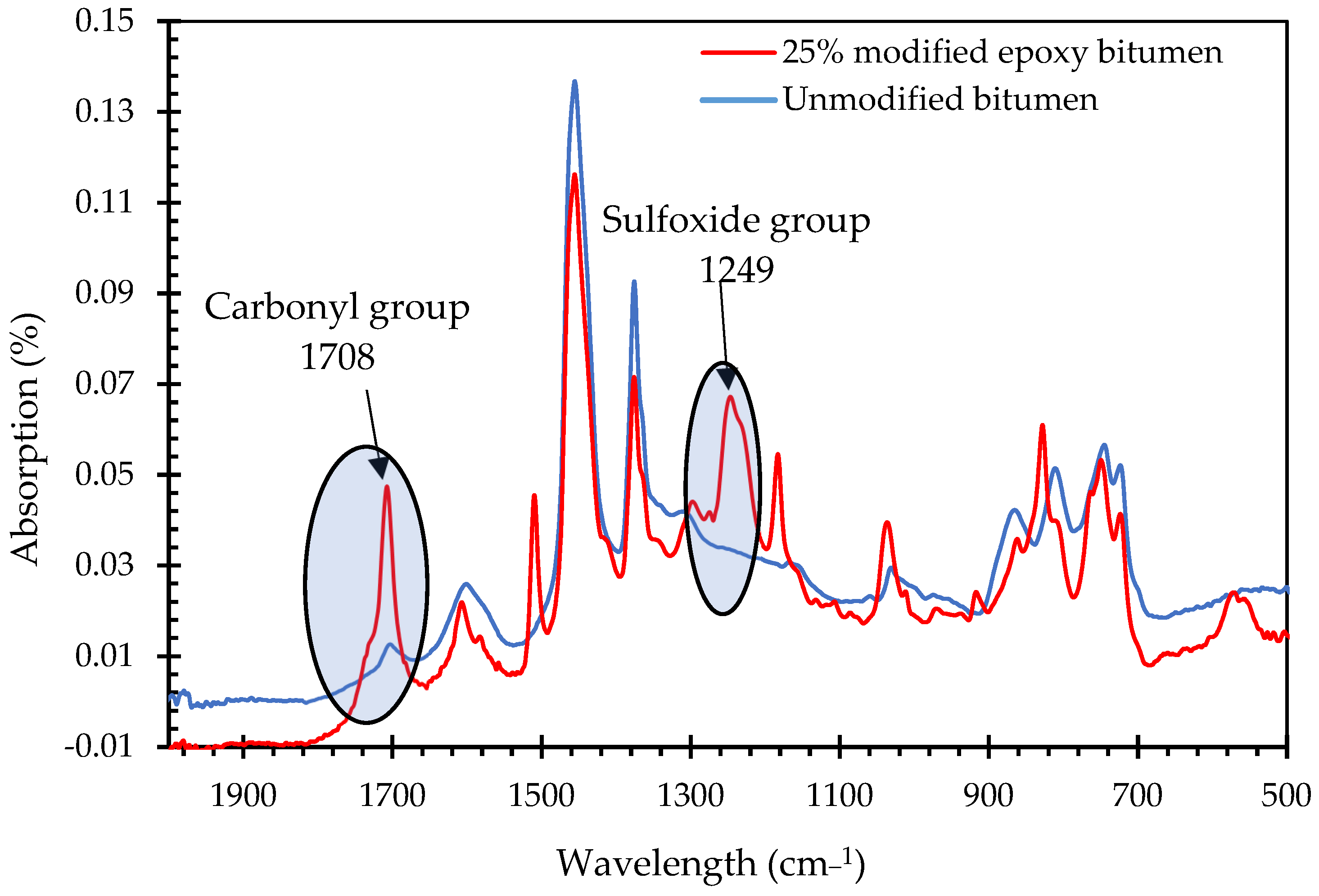

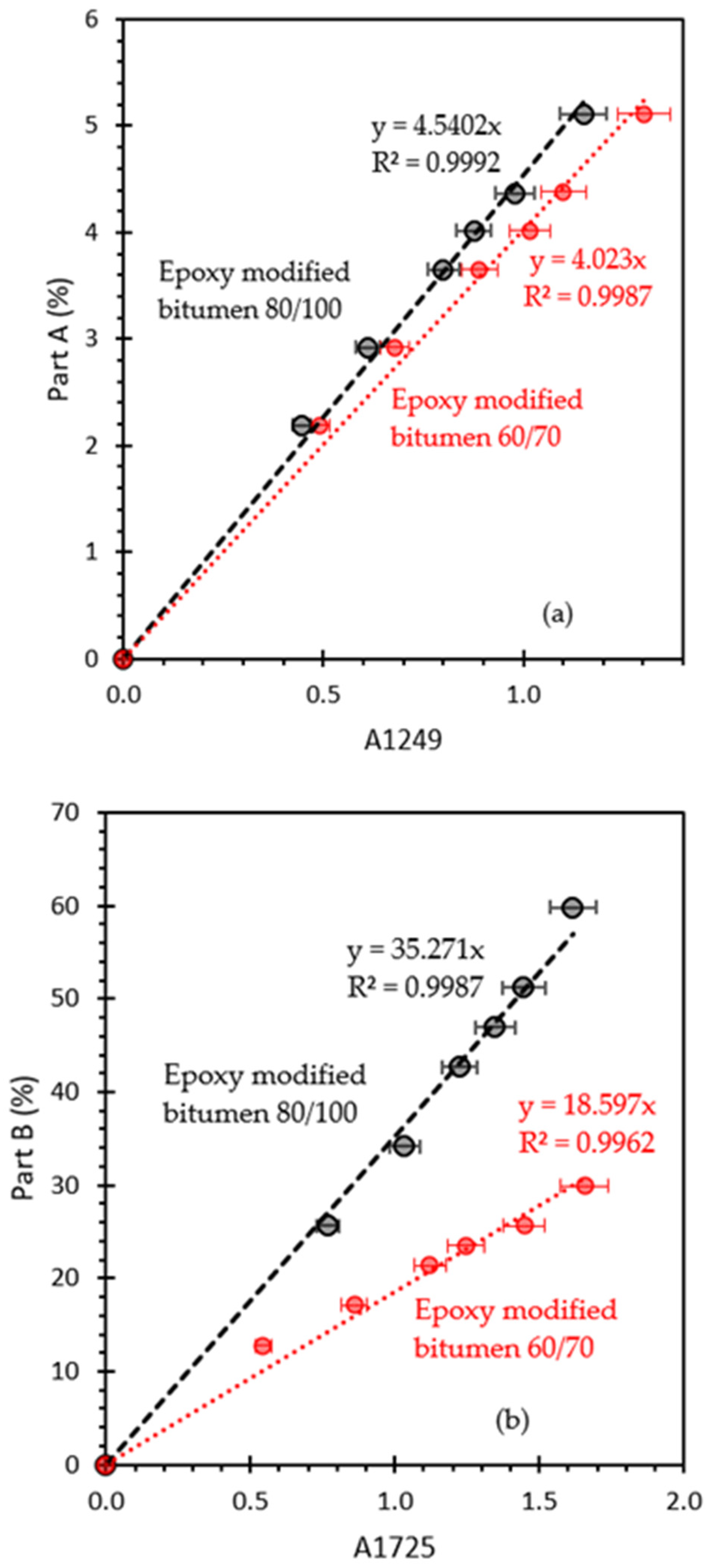


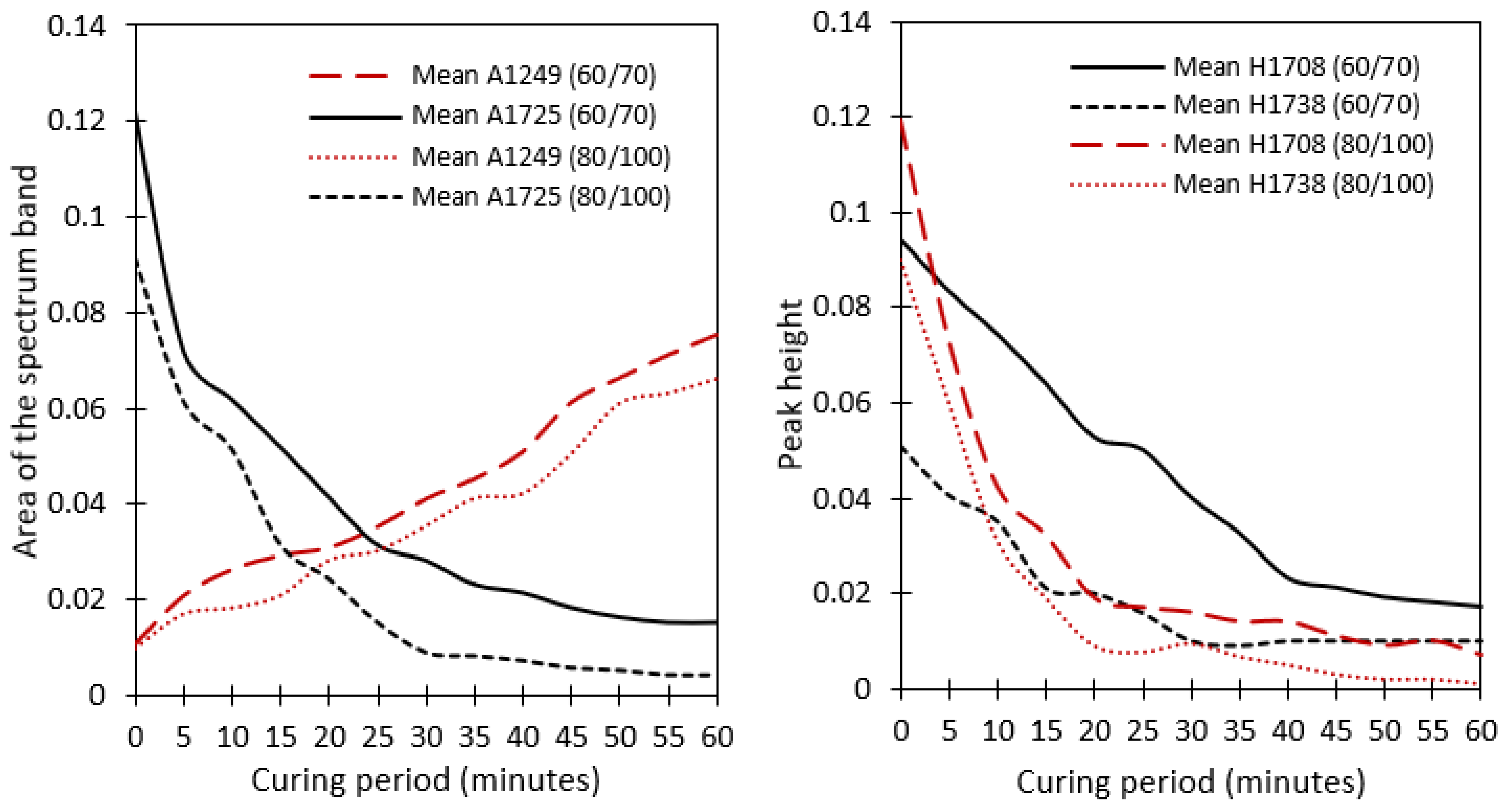
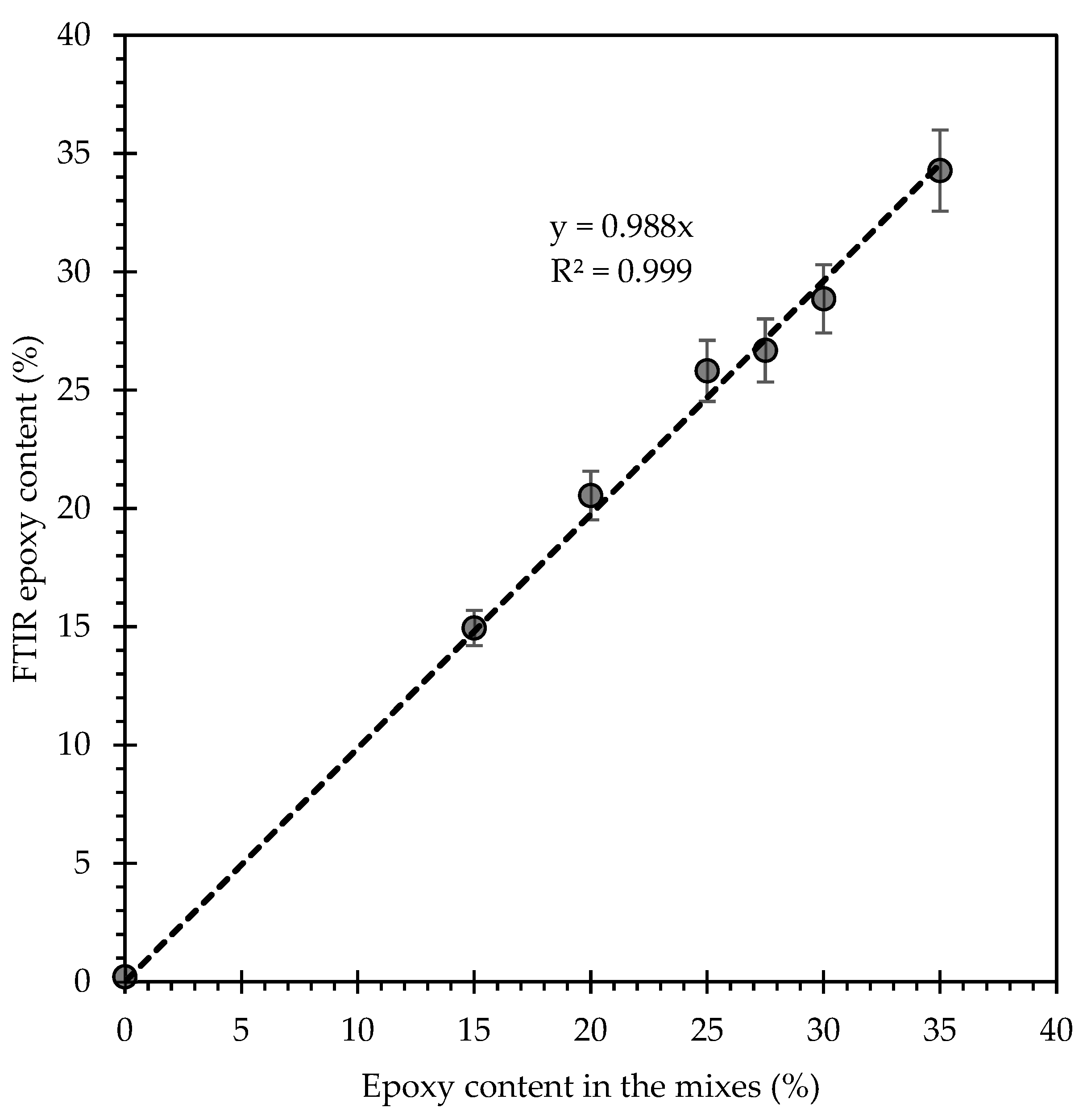
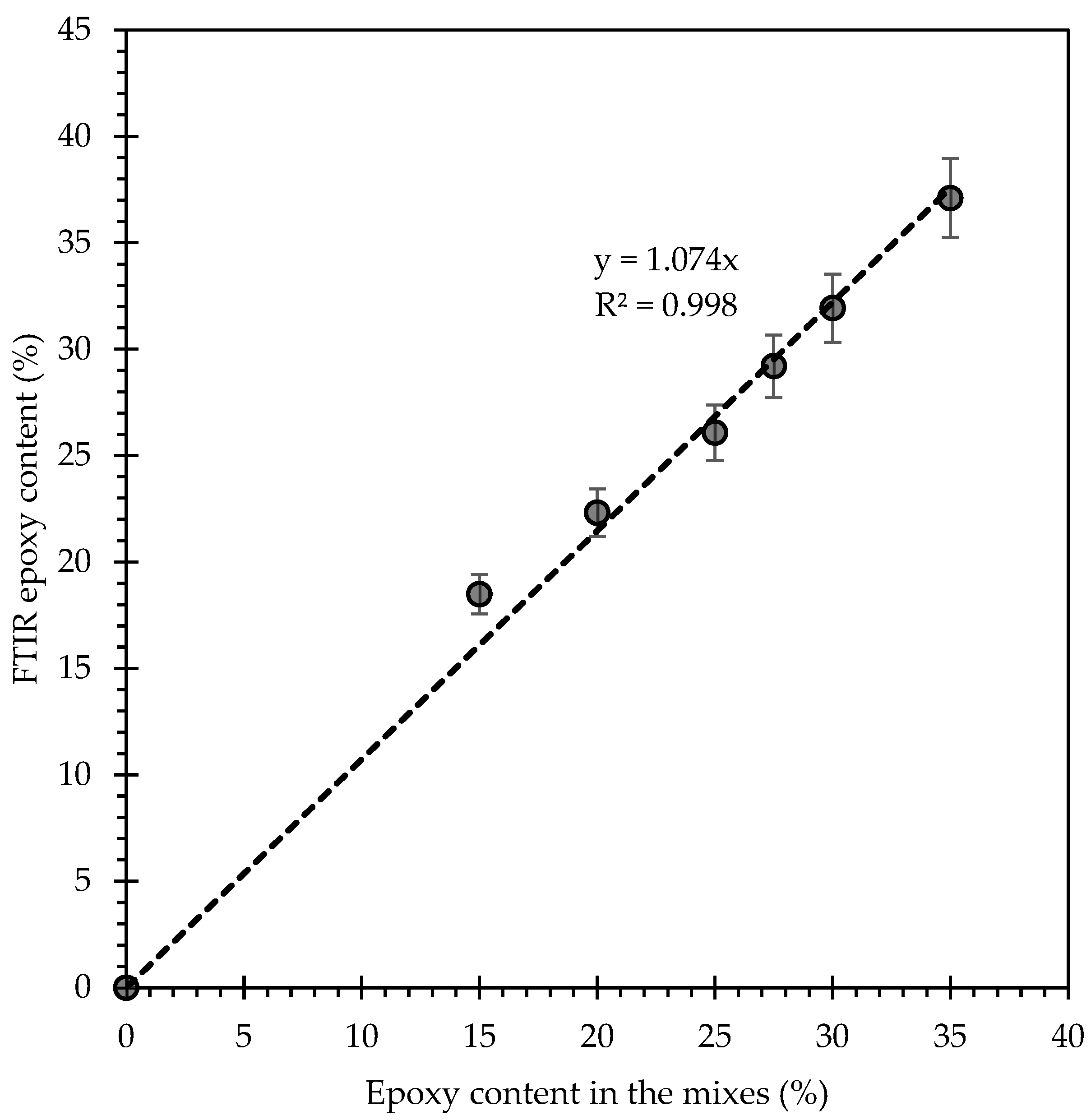
| Parameter | Methods | Evidence |
|---|---|---|
| Changes in carbonyl/sulfoxides molecules | FTIR tests | Changes in areas and peaks of spectral bands (a,b). |
| Effects of curing of epoxy resin in bitumen emulsion | Multiple stress creep recovery (MSCR) tests and FTIR tests | Adhesion, strength, fatigue performance, and rutting resistance of the binder were improved, making it suitable for cold recycling and cold-mix asphalt paving (c,d). |
| Kinetic parameters and polymerisation | Differential scanning calorimetry (DSC) | Calorimetric levels and overcuring reduced MEB’s workability. Polymerization rate affected the mechanical properties (e,f). |
| Tensile strength | Direct tensile tests (DTT), relaxation tests (RT) and dynamic shear rheometer (DSR) tests. | , for MEB than bitumen (g). |
| Thermal and rheological properties. | FTIR | Thermal and rheological properties were improved during mixing of materials and curing under room temperatures (h). |
| Ageing | Dynamic shear rheometer (DSR) and FTIR | Antiageing compounds (AACs) influenced bitumen’s long-term ageing. DSR’s crack model could evaluate fatigue performance of AAC-modified binder. Good correlation between carbonyl index and the fatigue of AACs-modified binders (i). |
| fatigue | and frequency sensitivity | , hence allowing longer curing time to satisfy construction standards (j). |
| Type of Test | N * | Bitumen Grade | Epoxy Content (%) | n ** | Part A (14.6%) (g) | Part B (85.4%) (g) | Bitumen (g) |
|---|---|---|---|---|---|---|---|
| Concentration calibration curves | 8 | 60/70 | 0.0 | 2 | 0.00 | 0.00 | 100.0 |
| 15.0 | 1 | 2.19 | 12.81 | 85.0 | |||
| 20.0 | 1 | 2.92 | 17.08 | 80.0 | |||
| 25.0 | 1 | 3.65 | 21.35 | 75.0 | |||
| 27.5 | 1 | 4.01 | 23.49 | 72.5 | |||
| 30.0 | 1 | 4.38 | 25.62 | 70.0 | |||
| 35.0 | 1 | 5.11 | 29.89 | 65.0 | |||
| Curing correction curves | 1 | 60/70 | 25.0 | 13 | 3.65 | 21.35 | 75.0 |
| Concentration calibration curves | 20 | 80/100 | 0.0 | 2 | 0.00 | 0.00 | 100.0 |
| 15.0 | 3 | 2.19 | 12.81 | 85.0 | |||
| 20.0 | 3 | 2.92 | 17.08 | 80.0 | |||
| 25.0 | 3 | 3.65 | 21.35 | 75.0 | |||
| 27.5 | 3 | 4.01 | 23.49 | 72.5 | |||
| 30.0 | 3 | 4.38 | 25.62 | 70.0 | |||
| 35.0 | 3 | 5.11 | 29.89 | 65.0 | |||
| Curing correction curves | 1 | 80/100 | 25.0 | 13 | 3.65 | 21.35 | 75.0 |
| Mixed Quantities (%) | FTIR Results for Epoxy Content (%) | Β | βstan | βdiff | Deviation (FTIR—Mixed) | ||||
|---|---|---|---|---|---|---|---|---|---|
| Epoxy Content | Part A | Part B | Part Acorr | Part Bcorr | Total | ||||
| 15.0 | 2.19 | 12.81 | 1.90 | 16.59 | 18.49 | 0.115 | 0.171 | 0.056 | −3.49 |
| 20.0 | 2.92 | 17.08 | 2.04 | 20.27 | 22.32 | 0.101 | 0.171 | 0.070 | −2.32 |
| 25.0 | 3.65 | 21.35 | 2.62 | 23.46 | 26.08 | 0.112 | 0.171 | 0.059 | −1.08 |
| 27.5 | 4.02 | 23.49 | 3.62 | 25.59 | 29.21 | 0.141 | 0.171 | 0.030 | −1.71 |
| 30.0 | 4.38 | 25.62 | 3.65 | 28.28 | 31.93 | 0.129 | 0.171 | 0.042 | −1.93 |
| 35.0 | 5.11 | 29.89 | 4.49 | 32.60 | 37.09 | 0.138 | 0.171 | 0.033 | −2.09 |
| Average deviation | −2.10 | ||||||||
| Mixed Quantities (%) | FTIR Results for Epoxy Content (%) | β | βstan | βdiff | Deviation (FTIR—Mixed) | ||||
|---|---|---|---|---|---|---|---|---|---|
| Epoxy Content | Part A | Part B | Part Acorr | Part Bcorr | Total | ||||
| 15.0 | 2.19 | 12.81 | 1.59 | 13.36 | 14.95 | 0.119 | 0.171 | 0.052 | −0.05 |
| 20.0 | 2.92 | 17.08 | 2.68 | 17.87 | 20.55 | 0.150 | 0.171 | 0.021 | +0.55 |
| 25.0 | 3.65 | 21.35 | 3.42 | 22.40 | 25.82 | 0.153 | 0.171 | 0.018 | +0.82 |
| 27.5 | 4.02 | 23.49 | 4.25 | 22.43 | 26.68 | 0.189 | 0.171 | −0.019 | −0.82 |
| 30.0 | 4.38 | 25.62 | 4.59 | 24.27 | 28.86 | 0.189 | 0.171 | −0.018 | −1.14 |
| 35.0 | 5.11 | 29.89 | 5.65 | 28.63 | 34.28 | 0.197 | 0.171 | −0.026 | −0.72 |
| Average deviation | −0.23 | ||||||||
Disclaimer/Publisher’s Note: The statements, opinions and data contained in all publications are solely those of the individual author(s) and contributor(s) and not of MDPI and/or the editor(s). MDPI and/or the editor(s) disclaim responsibility for any injury to people or property resulting from any ideas, methods, instructions or products referred to in the content. |
© 2023 by the authors. Licensee MDPI, Basel, Switzerland. This article is an open access article distributed under the terms and conditions of the Creative Commons Attribution (CC BY) license (https://creativecommons.org/licenses/by/4.0/).
Share and Cite
Ngezahayo, E.; Eskandari Torbaghan, M.; Metje, N.; Burrow, M.; Ghataora, G.S.; Desalegn, Y. Investigating the Effectiveness of Fourier Transform Infrared Spectroscopy (FTIR) as an Antifraud Approach for Modified Epoxy Asphalt Mixes in Developing Countries. Sustainability 2023, 15, 16332. https://doi.org/10.3390/su152316332
Ngezahayo E, Eskandari Torbaghan M, Metje N, Burrow M, Ghataora GS, Desalegn Y. Investigating the Effectiveness of Fourier Transform Infrared Spectroscopy (FTIR) as an Antifraud Approach for Modified Epoxy Asphalt Mixes in Developing Countries. Sustainability. 2023; 15(23):16332. https://doi.org/10.3390/su152316332
Chicago/Turabian StyleNgezahayo, Esdras, Mehran Eskandari Torbaghan, Nicole Metje, Michael Burrow, Gurmel S. Ghataora, and Yitagesu Desalegn. 2023. "Investigating the Effectiveness of Fourier Transform Infrared Spectroscopy (FTIR) as an Antifraud Approach for Modified Epoxy Asphalt Mixes in Developing Countries" Sustainability 15, no. 23: 16332. https://doi.org/10.3390/su152316332
APA StyleNgezahayo, E., Eskandari Torbaghan, M., Metje, N., Burrow, M., Ghataora, G. S., & Desalegn, Y. (2023). Investigating the Effectiveness of Fourier Transform Infrared Spectroscopy (FTIR) as an Antifraud Approach for Modified Epoxy Asphalt Mixes in Developing Countries. Sustainability, 15(23), 16332. https://doi.org/10.3390/su152316332








